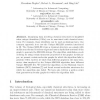DILS
2008
Springer
14 years 1 months ago
2008
Springer
It is not always clear how best to represent integrated data sets, and which application and database features allow a scientist to take best advantage of data coming from various ...
DILS
2008
Springer
14 years 1 months ago
2008
Springer
DILS
2008
Springer
14 years 1 months ago
2008
Springer
This paper concerns the research topic of data integration in the life sciences. The paper presents no technical results, but rather provides a classification of research activitie...
DILS
2007
Springer
14 years 1 months ago
2007
Springer
The success of mass spectrometry-based proteomics in emerging applications such as biomarker discovery and clinical diagnostics, is predicated substantially on its ability to achie...
DILS
2005
Springer
14 years 1 months ago
2005
Springer
Integrating data involving chemical structures is simplified when unique identifiers (UIDs) can be associated with chemical structures. For example, these identifiers can be use...
DILS
2006
Springer
14 years 3 months ago
2006
Springer
Public biological databases contain vast amounts of rich data that can also be used to create and evaluate new biological hypothesis. We propose a method for link discovery in biol...
DILS
2006
Springer
14 years 3 months ago
2006
Springer
DILS
2006
Springer
14 years 3 months ago
2006
Springer
Steps in scientific workflows often generate collections of results, causing the data flowing through workflows to become increasingly nested. Because conventional workflow compone...
DILS
2006
Springer
14 years 3 months ago
2006
Springer
Abstract. Grid computing has great potential for supporting the integration of complex, fast changing biological data repositories to enable distributed data analysis. One scenario...
DILS
2006
Springer
14 years 3 months ago
2006
Springer




